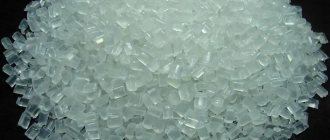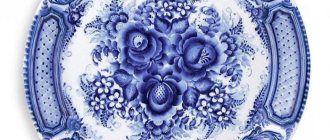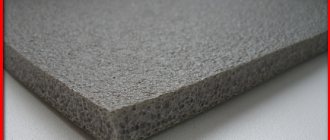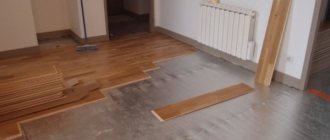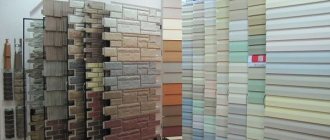What determines the quality of painting? Firstly, the correct application of the coloring composition. Secondly, a competent combination of some material parameters that determine the solution in this direction.
When painting and varnish work is carried out, the main indicator responsible for success will be the viscosity indicator.
Viscosity unit in seconds
The measured viscosity of paint or other liquids (oil) is proportional to the time period during which a certain volume of paint flows from a certain tube under the influence of a certain pressure.
Hence the conclusion is that viscosity as a parameter is evaluated in seconds. This is the time from the start of flowing out of paintwork from funnels or measuring cups until the first stop of the stream (flowing out to the last drop is not expected). The correct name of the parameter is “conditional viscosity”. The higher the indicator, the longer the liquid flows through the hole.
It will take no more than 3 minutes to measure the parameter, but it will help you figure out a lot.
How does viscosity affect other characteristics?
The answer to why it is necessary to measure the conditional viscosity parameter of a liquid lies in an explanation of what it affects:
- Too viscous paint does not spread well over the surface of the material.
- Too thick a layer of coating takes a long time to dry. A lot of production time is wasted.
- The strength of the coating at the finish is reduced if paint that is too thick in consistency is used.
- The adhesion of the paintwork material and the surface is reduced, since all irregularities on the surface are not filled with a thick composition.
- Defects appear in the form of smudges from a thick layer of coating.
- Cheap spray guns cannot cope with viscous material.
- Excessively diluted paint is applied in several layers to ensure a satisfactory result. More time is spent on work and the spray gun wears out.
Determining viscosity allows you to obtain paint that will provide a well-painted surface, reduce time for the production process, reduce material consumption and save inventory.
Filtering
The prepared paint and varnish material must be filtered before filling into the spray gun tank, since it may contain foreign inclusions that got there during the preparation process, clots, etc. Otherwise, it is impossible to guarantee a high-quality surface, because all this debris may ultimately end up on the surface being painted.
For filtration, it is convenient to use disposable paper funnels with a nylon filter insert (mesh size, usually 190 microns). I inserted the funnel directly into the tank, strained it - ready, you can paint!
We fill the paint tank only using a filter funnel.
How is the parameter measured?
The choice of unit of measurement depends on the choice of the paint manufacturer. Domestic paint manufacturers use the parameter designation in seconds; Imported paints are marked “DIN”.
This indicates the time, expressed in seconds, during which the liquid passes through a hole (of a given diameter). The liquid composition passes completely through the hole faster. For thicker ones, it will take longer to leave the container. The consistency of the liquid does not change the algorithm for using the viscometer.
Why thin the paint?
Most paints that are sold ready-made are thick and are mainly suitable for brush work. Painting with a roller or spray gun requires thinner paints. If you use paint whose viscosity does not correspond to the required parameter, you can damage both the surface to be painted and the painting device.
Description of the viscosity measuring device
A tool for measuring the viscosity of paintwork materials is a viscometer. The structure is very simple:
- 100 mm funnel-shaped container;
- a hole with a diameter of up to 4 mm through which liquid flows.
For accurate measurements of viscosity in everyday life, a viscometer is available for sale at a price of 200-500 rubles. The price of a device used in laboratories reaches 100 thousand rubles.
The viscometer is easy to use:
- Fill the funnel with liquid after closing the hole with your finger.
- The moment the hole is opened (by removing your finger), the stopwatch starts.
- The time when the container becomes completely empty is recorded. A few drops will not affect the viscosity value in DIN.
The accuracy of the determination by the device depends on the ambient temperature and the paint itself. The temperature indicator should be between 18o and 22o. It is known that the composition will thicken if the temperature of it and the air is below the required threshold. If the temperature is higher, then the density decreases. This means that the result of the parameter will not be correct.
If you need to make it thicker
If the LKS, according to the results of viscosity measurements, is more liquid than necessary, the situation can be corrected in two ways:
- Add a dye of the same composition, but thicker, remembering to stir until smooth. If an oil, alkyd or nitro-enamel composition needs correction, alkyd varnish (or another binder included in the composition of a particular dye) is suitable as a thickener.
- An open container with LCS can be left to settle so that part of the solvent evaporates (this will take from several hours to a day). The contents are stirred periodically and the jar is kept in a ventilated place.
Before starting work, you need to adjust the viscosity Source gama-alati.rs
About the influence of viscosity on the occurrence of coloring defects in the following video:
Optimal parameter values
On the packaging of coating materials, the manufacturer indicates the optimal viscosity parameter for the selected conditions. If this is not the case, then the data is on the viscous liquids website. General recommendations defining such compositions are indicated in the table.
| Type of material | Time period, sec. |
| Paintwork materials for painting cars | from 15 to 20 |
| Soil material | from 15 to 30 |
| Texture coating | from 15 to 25 |
| Glaze paint | from 20 to 30 |
| Latex look | from 35 to 45 |
| Oily in composition and enamel | from 15 to 25 |
If it is not possible to establish the exact parameter of paint viscosity due to the lack of a device, then the composition is brought to the consistency of milk. The manufacturer must indicate the type of diluent on the packaging. You cannot choose it spontaneously. So nitro enamel is not diluted with plain water. Each type of paint has its own thinner.
Additional properties
Depending on the composition and properties, solvents are divided into:
- Non-polar, including hydrocarbons in a liquid state, are kerosene and white spirit.
- Polar, the chemical form of which has a group (OH). The related alcohols are used to dissolve water-based paints and acrylic enamels.
When choosing a solvent, take into account that the polar group is suitable only for those paints and varnishes that are considered polar, and vice versa. Xylene and benzene are universal solvents that can be combined with any coloring matter.
How two-component dyes are diluted
Information on how two-component dyes are diluted is studied separately. The principle of achieving the correct viscosity is different.
- Hardener is added to the paint in strict proportions. It is important to comply with the norm, otherwise the strength of the coating will suffer.
- The viscosity parameter is checked separately with a viscometer. A solvent may be needed.
A measuring container is used to measure and select the required amount of base and hardener if the volume of paint is not large.
A measuring ruler is also used in such situations. The accuracy of measurements will not be impaired under one condition: the container is used only in the form of a cylinder. Important: the bucket is shaped like a cone. For example, paint without a hardener in a cylinder is poured to the level of the 40 cm mark, then the proportion of 1:4 will be maintained if the thinner is added to the height of the 50 cm mark. Only after adding a hardener are two-component dyes diluted.
Making a batch
Before filling the gun, you should mix the components of the purchased paint.
For proper mixing of the components, which produces a painting material of the required viscosity, the following conditions must be met.
Dishes
It is important that the container in which we mix is strictly cylindrical in shape (flat bottom and vertical walls). Only in such a container can you mix the components evenly and measure their quantities correctly.
It is better if it is a special measuring container in the form of a transparent plastic jar with a lid. Such cans are marked with markings that allow mixing materials in the required volume ratio (1:1, 2:1, 3:1, 4:1, 5:1, etc.).
Measuring containers are available in different volumes, ranging from 100 ml to almost half a bucket
Also, for dispensing and mixing paints and varnishes, it is convenient to use a special ruler with marks that determine the volume fractions of the components.
Pour the base into a cylindrical container to a certain division, and then add the hardener (if added) to the required mark, then the solvent. Mix everything with the same ruler - and you're done. Often, a measuring ruler is sold along with a set of paint, and all branded cans indicate the proportions according to these rulers.
It is convenient to measure the required amount of components using a measuring ruler. Then I chatted with the same ruler - and that’s it.
Proportions
Given the abundance that has reigned on the paint and varnish market, it is, as they say, impossible to give one recipe for all occasions by definition. Yes, and you don’t need to do this. There is TDS - you know who the rest is from.
However, it would be useful to provide some general guidelines. In principle, we already talked about them a little higher: up to 50% hardener and 10-20% thinner are usually added to two-component products. The degree of dilution of base enamels usually ranges from 50-80%. Well, look at the exact proportions in the instructions for a specific product: all can varnishes and enamels have instructions in the form of pictograms that inform you in what proportion you need to dilute the paint with the hardener (if the material is two-component) and thinner.
We remind you: only thinner is added to one-component materials (alkyds, base enamels, 1K primers); In two-component materials (acrylic enamels and varnishes, 2K primers), a hardener is first added, then the mixture is brought to the desired viscosity with a thinner.
If you order paint for selection in a laboratory, then you will be given a set of components (usually ordered as a set), by mixing which you will get a ready-to-use material with a working viscosity - as they say, “for a spray.” Or they will give you paint that has already been diluted (of course, this only applies to the base, since the lifetime of two-component materials after mixing is strictly limited).
Supplements
A description of recipes for preparing paint cocktails would be incomplete without mentioning additives - materials used to change the individual characteristics of enamels, varnishes or primers.
For example, to create a rough surface - very often plastic bumpers of SUVs are painted this way - there are structural additives of varying degrees of granularity. In general, to prevent paint on plastic from cracking, 20-40% plasticizer must be added to it. There are matting elasticizers designed to reduce the shine and color of plastic parts such as side trims on Mercedes-Benz cars.
When painting with spectacular two-layer coatings, these additives must be mixed with the topcoat varnish (it is recommended to add a plasticizer to the filler primer as well). Read more about supplements and their uses here.
Viscosity measuring cup standard
Bowls of several standards are used in this work:
- according to Russian GOST 9070-75 – these are VZ-246 funnels;
- analogue from a European manufacturer - DIN 53211-87;
- European bowls, for products from America - FORD or ASTM D funnels The shape of a truncated cone with a widened neck and a narrowed hole at the bottom with a given diameter.
According to European standards, 5 types of bowls are used with the same capacity of 100 ml, but with holes at the bottom of different diameters: 2 mm, 3 mm, 4 mm and 6 mm, 8 mm.
FORD bowl VZ-246
The FORD bowl differs from the domestic viscometer in its holes. Physical viscosity increases if the hole diameter increases and the flow time does not change.
In laboratories, cup models are used, and in everyday life, a submersible device is used. Knowing the principle and features of its operation at home, it is not difficult to make a viscometer for paint with your own hands.
The material used to make the bowls of the device can be easily removed from paint. The tripod handle is height adjustable. Under production conditions, the test dose is supplied to the container by a special automated micropump. The capillary viscometer is characterized by high accuracy in measuring the viscosity index of paintwork materials.
Content:
With the help of a spray gun, you can do not only painting, but also perform such work as whitewashing the ceiling, applying varnish to wooden products, spraying plants, treating the car body with anti-corrosion compounds and much more.
Before choosing a spray gun, think about the purposes for which you will use it. One tool is suitable for painting a bench, battery, or swing. For larger objects, for example, walls, fences, roofs, doors, you need to purchase a more productive model. Therefore, in order not to spend extra money on something that you cannot work with, when purchasing, you need to pay attention to the technical characteristics.


